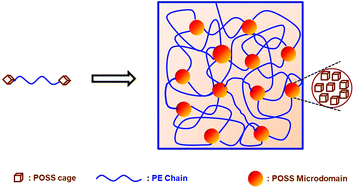Polyethylene telechelics with POSS termini: synthesis, morphologies and shape memory properties†
Abstract
Organic–inorganic polyethylene (PE) telechelics with polyhedral oligomeric silsesquioxane (POSS) termini were synthesized via the combination of acyclic diene metathesis (ADMET), ring-opening metathesis polymerization (ROMP) and hydrogenation reactions. First, a di-POSS chain transfer agent (denoted POSS-CTA) was synthesized via ADMET of hexenyl POSS by using the Grubbs second generation catalyst. The POSS-CTA was used to mediate the ROMP of cyclooctene (COE) to obtain polycyclooctene (PCOE) telechelics. The PCOE telechelics were then hydrogenated into PE telechelics. The PE chains in the organic–inorganic telechelics displayed high crystallinity. Morphological observation showed that the terminal groups of POSS of the telechelics were aggregated into microdomains via POSS–POSS interactions. The POSS microdomains had a diameter of 10–40 nm and behaved as the netpoints of physically-crosslinked PE networks. More importantly, the organic–inorganic PE telechelics were capable of displaying shape memory properties, which are generally possessed by chemically-crosslinked and/or ultrahigh-molecular-weight PE. Notably, the shape memory properties were quite dependent on the lengths of PE chains.



 Please wait while we load your content...
Please wait while we load your content...